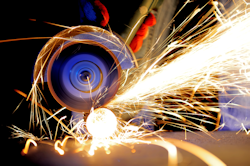Caught-In or -Between Protective Measures
Clothing and Jewelry
Protective clothing and equipment can create hazards. A protective glove can get caught between rotating parts. Also, a respirator face piece which hinders the wearer's vision requires alertness and continued attentiveness whenever they are used.
Other parts of the worker's clothing may present additional safety hazards. For example:
- Loose-fitting shirts might become entangled in rotating spindles or other kinds of moving machinery.
- Jewelry, such as bracelets and rings, should not be worn because they can catch on machine parts or stock and lead to serious injury by pulling a hand into the danger area.
Machine Guarding
Reciprocating, rotating or moving parts of equipment must be guarded if they are exposed to contact by workers.
Machine guards are barriers that prevent access to danger areas such as moving parts. There are four general types of guards:
- Fixed: A fixed guard is a permanent part of the machine. It is not dependent upon moving parts to function.
- Interlocked: When this type of guard is opened or removed, the tripping mechanism and/or power automatically shuts off or disengages, the moving parts of the machine are stopped, and the machine cannot cycle or be started until the guard is back in place.
- Adjustable: Adjustable guards are useful because they allow flexibility in accommodating various sizes of stock.
- Self-adjusting: The openings of these barriers are determined by the movement of the stock. As the operator moves the stock into the danger area, the guard is pushed away, providing an opening which is only large enough to admit the stock. The openings of these barriers are determined by the movement of the stock. As the operator moves the stock into the danger area, the guard is pushed away, providing an opening which is only large enough to admit the stock.
Guards must not be easy to defeat and they must now allow access to moving parts from any direction. Never remove a safety guard when a tool is being used. Hazardous moving parts of power tools and equipment need to be safeguarded. Some examples of parts that need to be guarded are: belts, gear, shafts, and pulleys.
Knowledge Check Choose the best answer for the question.
4-1. What is required if a worker is exposed to contact with moving parts of equipment or machinery?
You forgot to answer the question!

